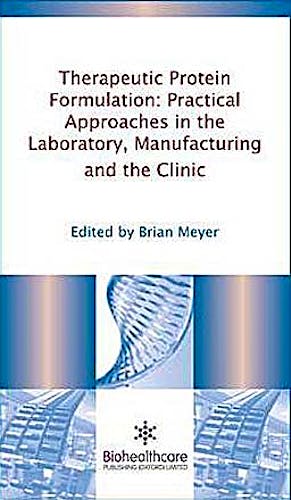

No hay productos en el carrito



Therapeutic Protein Formulation: Practical Approaches in the Laboratory, Manufacturing and the Clinic
Meyer, B.
1ª Edición Diciembre 2011
Inglés
Tapa dura
220 pags
1000 gr
null x null x null cm
ISBN 9781907568183
Editorial Biohealthcare Publishing
LIBRO IMPRESO
-5%
162,71 €154,57 €IVA incluido
156,45 €148,63 €IVA no incluido
Recíbelo en un plazo de
2 - 3 semanas
Summary
This book provides a comprehensive overview of the process of formulating therapeutic proteins in the laboratory, manufacturing and administration in the clinic. The laboratory formulation section focuses on platform vs. high-throughput testing and buffers, excipients, and pH ranges that are commonly tested. A brief section on biophysical and analytical analysis is also provided. The formulation manufacturing process, covered in detail, includes bulk drug substance (BDS) manufacture during the final stages of purification, BDS storage and shipping, formulation and filling, and drug product shipping. An emphasis is placed on material and process testing to ensure success during manufacturing. The propensities for formulated therapeutic proteins to aggregate may be associated with processing, and include high concentration products, phase separation, opalescence, and subvisible particles. Methods of delivery in the clinic are addressed, including single- and multi-dose images containing antimicrobial preservatives as well as delivery strategies. Finally, a perspective on the regulatory requirements for therapeutic protein formulations is discussed.
Key Features
• The book provides a comprehensive and practical overview of protein
formulation in the laboratory, manufacturing, and the clinic
• The book discusses recent topics including high protein concentration,
phase separation, opalescence, and subvisible particles, as well as new trends
in drug delivery
• New technologies that have emerged in the past five years that have
changed how therapeutic proteins are formulated and administered in the clinic
are also considered
• Recommendations are made as to how therapeutic proteins can be evaluated
at the pilot scale prior to manufacturing, with an emphasis on material and
process compatibility testing
• The book provides a regulatory perspective on therapeutic protein formulation,
specifically topics related to subvisible particles
Content
- Commercial therapeutic proteins - table of marketed therapeutic proteins; table of the most common buffers, excipients, and pH ranges in commercial products
- Pre-formulation screening - platform approach; high-throughput approach
- Bulk drug substance manufacture - final stages in purification -manufacture of final formulation buffer
- Bulk drug substance storage and shipping - single-use (disposable) containers; reusable containers; frozen vs. 2-8 C storage; compatibility testing; shipping considerations
- Formulation - formulation of drug substance to drug product; mixing; storage
- Filling - in-line filtration; tubing and peristaltic pumps; rolling diaphragm pumps; linear peristaltic pumps; positive-displacement piston pumps; container selection
- Drug product shipping - packaging; shipping considerations
- Administration in the clinic: delivery - chemical modifications to therapeutic proteins; intravenous; subcutaneous; intramuscular Subvisible particles - sources; methods of evaluating; current trends; regulatory
- Regulatory requirements - compendial testing; future state
- Appendix - definitions
Readership
The book is primarily directed towards professionals within the biotechnology and pharmaceutical industries; it is also of interest to those in academia.
Author
The editor, Dr Brian K. Meyer, is a Research Fellow in Bioprocess Research and Development, Merck Research Laboratories (MRL). Dr Meyer and his team are responsible for formulating therapeutic proteins in pre-clinical development. Prior to joining MRL, Dr Meyer was a Process Scientist in Vaccine Technology and Engineering, Merck Manufacturing Division. He has a Ph.D. in Biochemistry, Microbiology, and Molecular Biology from The Pennsylvania State University and a B.S.E. in Biomedical Engineering from Tulane University.
© 2025 Axón Librería S.L.
2.149.0